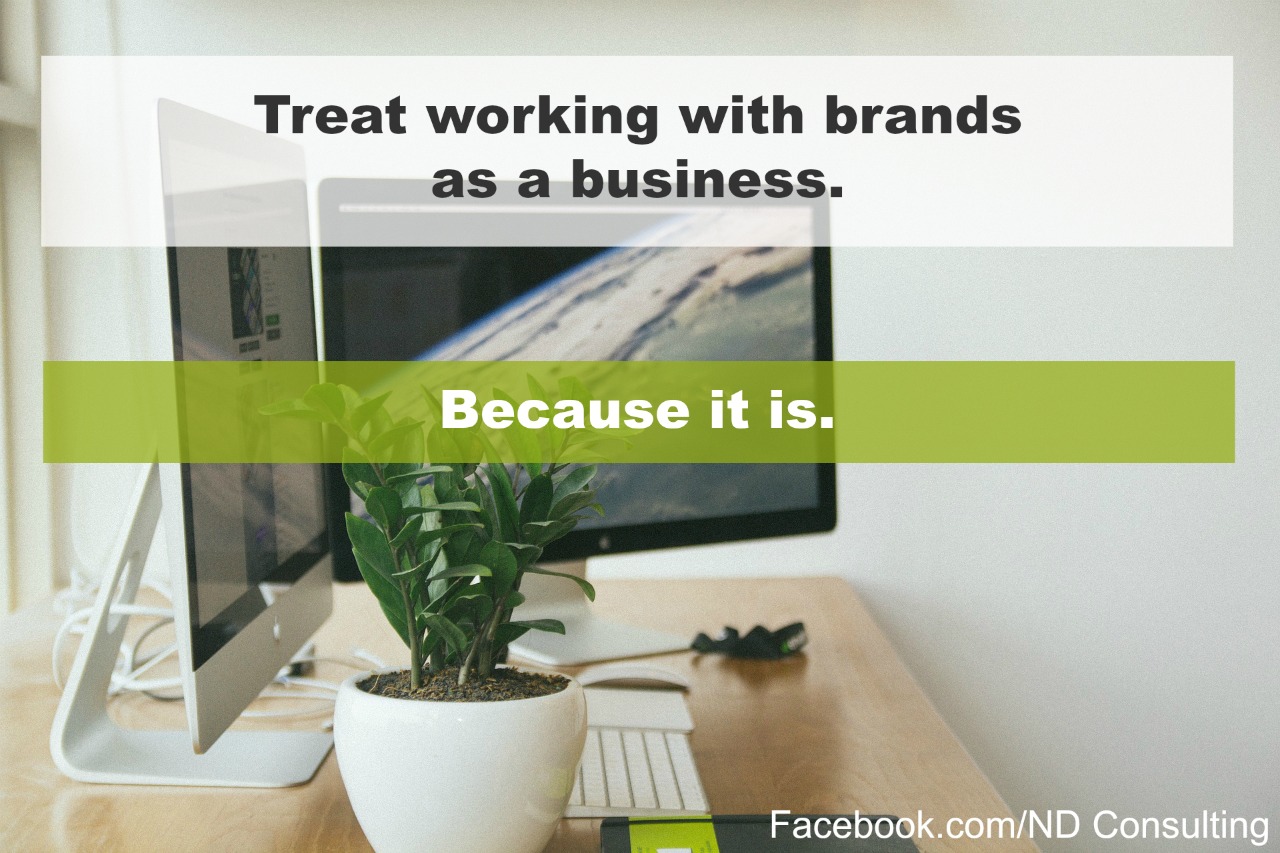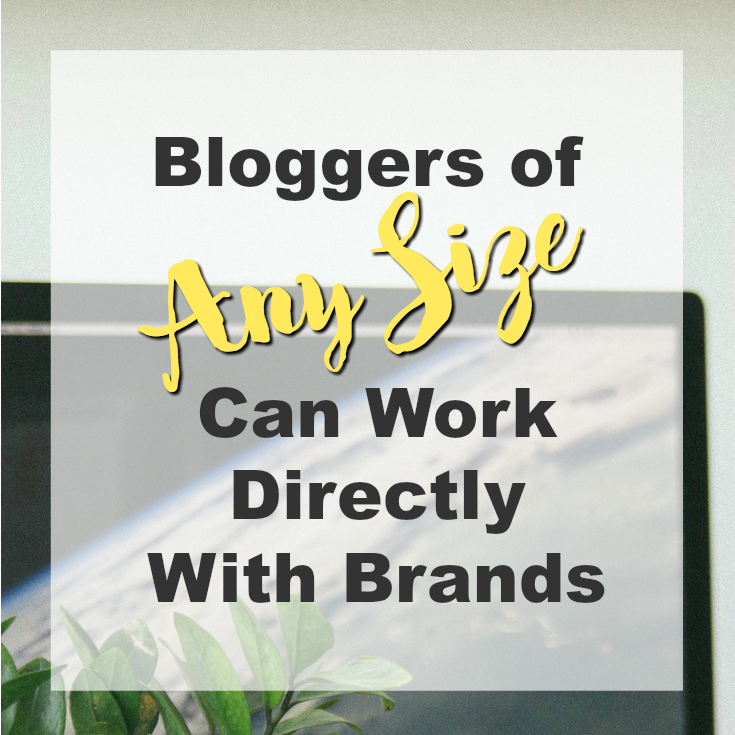If you’re a blogger, you can work with brands to increase income from your blog, no matter your following! Join us as we take you through a summary of a top blogger’s tips to make money working with brands without the middle man.

I originally wrote this article for the International Bloggers’ Association. I am vice-president for the organization and would love for you to join the IBA, an organization which seeks to elevate all bloggers.
A blogger doesn’t need a Twitter account with 100,000 friends or an Instagram account with 50,000 followers to successfully make money and work with brands directly. If the platform allows it (Blogger, WordPress.com, WordPress.org, etc.), you CAN work with brands without a middle-man agency.
Why would bloggers work with brands directly?
When one is looking to monetize (make money from) their online space, bloggers can do any number of activities that will bring in revenue. A very popular option for website owners is to join a network that connects bloggers to brands.
An upside to this relationship, among others, is that the connection is made for you. The downside with that relationship, among others, is that most networks require specific ‘reach’ minimums. If you’ve tried to join a few, you might know that a lot of small and mid-sized bloggers just don’t have the reach those networks require.
Don’t forget to sign up to get access to the valuable Resource Library!
Get Free Access to Our Resource Library!
How does a blogger get started working with brands?
There are some basic requirements a blogger must have to successfully begin to work with brands directly. First and foremost: you need to know your price, and that price is considerably more than “free” or “for exposure.” Your time, your energy, your creativity – those are all valuable to a brand, and there are so many companies who know that to connect to the market, they will need to pay.
We were fortunate enough to interview a rock-star blogger (and new IBA member), Amanda Love of Growing Up Madison, who has been working with brands while maintaining a growing readership. To support our “Top 5 Tips Series” on the International Bloggers’ Association’s Blab.im channel, Amanda offered up helpful advice on how to work with brands without an agency.
What was supposed to be a 30-minute chat, turned into an hour of tips, tricks, and an amazing question and answer session! We knew these tips would be valuable to many, and because this particular Blab was not recorded, we are publishing the tips and techniques this talented group of bloggers shared.
Top 5 Tips to Work with Brands
1. Contacts
Always try to submit pitches or proposals to companies with a contact. PR releases are excellent places to find PR contacts. Subscribe to PR Newswire or specific brand’s releases to obtain names, learn about new products, and even get creative ideas for pitching. Fellow bloggers (via tribes, sharing groups, etc.) are also excellent ways to find contacts and opportunities. Don’t be afraid to ask!
2. Before the Campaign
Make an effort before the campaign is awarded. Pre-promotion goes a long way to establishing a relationship with a brand. Share and tag the brand highlighting their product(s) before you pitch. Pro Tip: this is also a great way to gain contacts.
3. The Pitch
Pitch letters should be specific. Within your short, succinct email, spell out what you’re going to do for the company and what they can expect. Propose your idea (not too much detail) and when they are interested, quote them a price, a detailed proposal, and/or send them your media kit. Give them a week to process your pitch and check in with them only once if you haven’t heard back.

4. Your Business
Not only should all communications be professional, but one should treat working with sponsored content as a business – because it is. A blogger should have their accounting and processes set up to track revenue coming in, statistics for campaign reporting, due dates for all contracts, invoice brands, and a method to efficiently (and accurately) report results at the end of a campaign.
While you are working on the campaign, document all scheduled shares, parties, and promotions you manage. Copy and paste the share URLs into a spreadsheet, for example, to easily tally and report on those shares for reporting at the end of the campaign. It will also be beneficial if you track the amount of time you spend on each campaign because it will help you develop a realistic rate, making sure you are compensated accurately.
Pro tip: be prepared to invoice at the time the campaign statistics are delivered back to the brand. This reduces the amount of back and forth emails and begins the (sometimes lengthy) payment process.
5. A Portfolio of Work
Leverage your work for additional work with the same brand. If you do a great job, position another partnership or put it on your calendar to reach out in the future (save all contacts). Use your sponsored work to gain additional work with other brands and agencies. Keeping this in mind, be sure that you are putting your best foot forward and you aren’t “copy and pasting” product features that someone could read off a description on a website. You are unique and your sponsored work should be no exception to that.
10 Additional Tips for Direct Brand Work
The question and answer section of the chat was filled with amazing information. Attending a live discussion is a way to get your questions answered by successful, money-making bloggers! Below are some discussion points bloggers found helpful:
Reach does not equal worth.
A perk of working directly with brands is that you do not have to have a huge social network (and massive reach) to make money with the relationship. Position your ideas, your ideal readers, your engagement, and your overall enthusiasm for their product.
Know your price.
How do you determine what to charge? There are resources on the web that will help you calculate a rate, but keep in mind: you determine what your time is worth. Think of it as if you were being paid by the hour: if you know the average time it takes you to write a post, calculate that plus the invoicing, tracking, and social media scheduling.
There is a cost to “free.”
Working for free isn’t always free. A blogger’s time, effort, creativity, value of product for taxes, and opportunity costs should be considered.
Streamline your process.
You will be rejected – accepting it is difficult, however, one way to help process rejection and move on is by using templates. For example, how do you respond to the “our company has no budget for this type of marketing?” Respond respectfully (preferably with a template so you can copy and paste), stating you will keep their contact information and you urge them to do so as well. Note that you look forward to working with them in the future when a budget is allocated.
If they want you to work for a product (and you are okay with that), adjust your proposal accordingly (for example, a few social shares to your network instead of a post on your site and full promotion). Using templates allows you to quickly respond with respect and also give you the courage to ask for your second choice opportunity. Fear and procrastination often get in the way and the use of templates helps to minimize this.
Media Kits.
Should you send your media kit out with every pitch letter? No. Most brands won’t ask for it and you could be limiting yourself if your rates are in it. Have one prepared but don’t automatically send it out before you have a chance to “woo” them with your strengths.
Be strategic, be smart, be assertive.
If you haven’t worked with a smaller or lesser known company before, you can propose payment before the campaign launches. It reduces the value of the campaign (for you) if you have to spend weeks tracking down payment. Additionally, it can hurt the relationship you have with that brand.
Get over the fear of rejection.
Don’t be afraid to pitch a brand. The worst that can happen is that they say no. See the above tip to streamline your process through templates – they really help to take the fear away!
Evergreen payments.
Ask brands if they have affiliate programs or partner referral coupons in place. By identifying either, you can get your work to pay dividends.
Identify your opportunities.
Many people are stymied about finding brands to pitch. You can begin by pitching products you use daily, are curious about, or are local to you. Pitching brands who have products, services, or travel perks you’re interested in is as easy as making a top 5 list.
Pro tip: keep your ideal readers in mind when selecting products and identifying opportunities. The worst thing that can happen is you lose sight of what they want and lose their trust.
Timing is key.
For example, some brands start Christmas contracts in the late summer / early fall. When brands are changing the design (even just the packaging) of a product, they often want to promote to remove the inventory. Keep an eye out for announcements like that and create an opportunity for yourself.
Summary
You can work with brands to increase income from your blog, no matter your following! Share these tips from top bloggers on Pinterest!




Excellent info. Are sample templates and tracking sheets provided on your site?
This is an excellent article. It really says exactly what one needs to have in place to pitch to brands. I am in the process of locating help with writing the pitch and the proposal. I appreciate you actually saying where to find the contact information. Thank you.